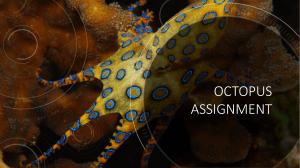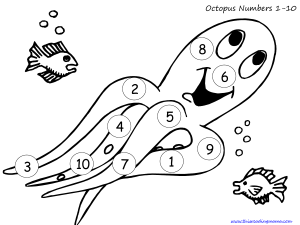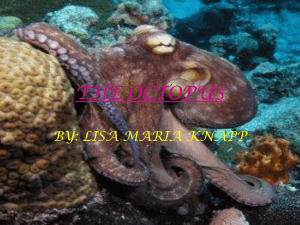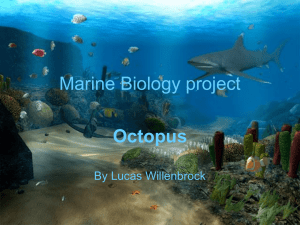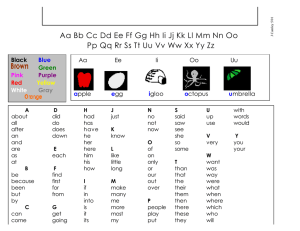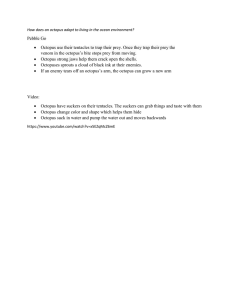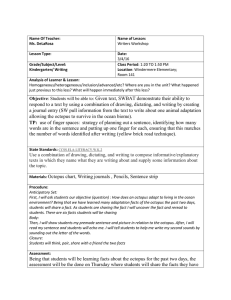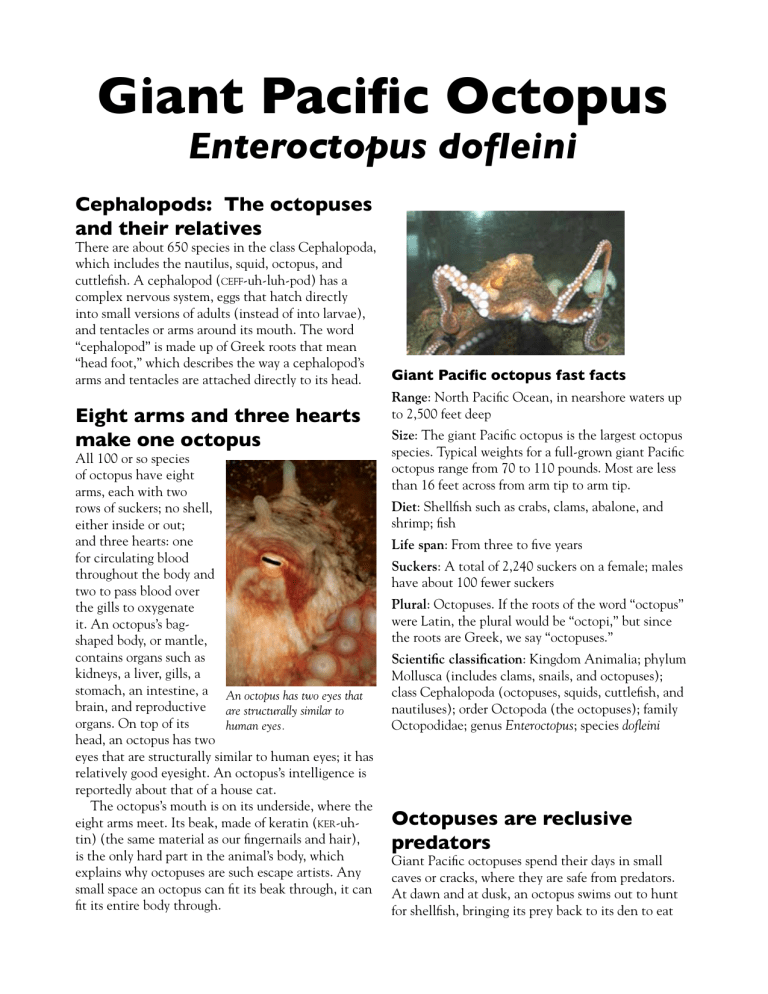
Giant Pacific Octopus Enteroctopus dofleini Cephalopods: The octopuses and their relatives There are about 650 species in the class Cephalopoda, which includes the nautilus, squid, octopus, and cuttlefish. A cephalopod (ceff-uh-luh-pod) has a complex nervous system, eggs that hatch directly into small versions of adults (instead of into larvae), and tentacles or arms around its mouth. The word “cephalopod” is made up of Greek roots that mean “head foot,” which describes the way a cephalopod’s arms and tentacles are attached directly to its head. Eight arms and three hearts make one octopus All 100 or so species of octopus have eight arms, each with two rows of suckers; no shell, either inside or out; and three hearts: one for circulating blood throughout the body and two to pass blood over the gills to oxygenate it. An octopus’s bagshaped body, or mantle, contains organs such as kidneys, a liver, gills, a stomach, an intestine, a An octopus has two eyes that brain, and reproductive are structurally similar to organs. On top of its human eyes. head, an octopus has two eyes that are structurally similar to human eyes; it has relatively good eyesight. An octopus’s intelligence is reportedly about that of a house cat. The octopus’s mouth is on its underside, where the eight arms meet. Its beak, made of keratin (ker-uhtin) (the same material as our fingernails and hair), is the only hard part in the animal’s body, which explains why octopuses are such escape artists. Any small space an octopus can fit its beak through, it can fit its entire body through. Giant Pacific octopus fast facts Range: North Pacific Ocean, in nearshore waters up to 2,500 feet deep Size: The giant Pacific octopus is the largest octopus species. Typical weights for a full-grown giant Pacific octopus range from 70 to 110 pounds. Most are less than 16 feet across from arm tip to arm tip. Diet: Shellfish such as crabs, clams, abalone, and shrimp; fish Life span: From three to five years Suckers: A total of 2,240 suckers on a female; males have about 100 fewer suckers Plural: Octopuses. If the roots of the word “octopus” were Latin, the plural would be “octopi,” but since the roots are Greek, we say “octopuses.” Scientific classification: Kingdom Animalia; phylum Mollusca (includes clams, snails, and octopuses); class Cephalopoda (octopuses, squids, cuttlefish, and nautiluses); order Octopoda (the octopuses); family Octopodidae; genus Enteroctopus; species dofleini Octopuses are reclusive predators Giant Pacific octopuses spend their days in small caves or cracks, where they are safe from predators. At dawn and at dusk, an octopus swims out to hunt for shellfish, bringing its prey back to its den to eat in peace. And the octopus can be an ambush predator—if an animal should pass by its den, that’s even better than having to go out hunting. It’s not above a bit of scavenging, either, if it comes across an animal that’s already dead. To eat live prey, an Any small space an octopus octopus first bites it can fit its beak through, it can with its beak and injects fit its entire body through. venom to paralyze the animal. An enzyme that the octopus then injects begins to break down the animal’s protein, softening its muscles and internal organs over the course of two or three hours. Then the octopus slurps the nearly liquid food out with its rasping tongue, called a radula (rad-yoo-lah). When it’s finished, the octopus pushes the remains out A giant Pacific octopus has the opening of its den, about 2,000 suckers, used for creating an “octopus feeling, tasting, and pulling. If garden” of empty shells. all used together, they could pull Giant Pacific more than 700 pounds. octopuses are preyed upon by seals and sea lions, sea otters, some fish, and larger octopuses. An octopus might try to use jet propulsion to escape, suddenly expelling water from its body through its siphon. Or it might squirt “ink” from its siphon, creating a false octopus shape that confuses the predator while the real octopus jets away. Like many other cephalopods, an octopus can change colors in the blink of an eye. An octopus has color patterns for camouflage, attack, escape, sex, food, and curiosity. When a giant Pacific octopus is resting, it is almost white; when it is aroused, it turns bright red. When it is somewhere in between, it can show a striking mottled pattern. This publication was funded by the National Sea Grant College Program of the U.S. Department of Commerce’s National Oceanic and Atmospheric Administration, under NOAA grant number NA060AR4170010 (project number A/ESG-4) and by appropriations made by the Oregon State legislature. The views expressed herein do not necessarily reflect the views of any of those organizations. Text by Eileen Flory, museum/education assistant, Hatfield Marine Science Center Oregon ORESU-G-07-002 Making more octopuses Octopuses come in two sexes. On the third arm on the right side of the male, the final four inches are modified into an organ called a hectocotylus (hectuh-kaw-t’l-us), a structure without suckers that is used to insert sperm ropes into the female’s mantle cavity. The female attaches her fertilized eggs—tens of thousands of them—to the roof of her den and stays with them for five or six months until they hatch. Without ever eating, she guards the eggs from predators and blows water over them to keep them clean and make sure they get oxygen. Once the eggs hatch, the female dies. After mating, the male also stops eating and eventually dies. When they hatch, young octopuses are about a third of an inch long and resemble adults, complete with suckers on their arms, ink sacs, and other distinctive octopus features. Nearly all of these tiny animals are eaten by fish and other sea creatures. With luck, though, one or two will survive to grow up and reproduce, continuing the long line of versatile, graceful, intelligent octopuses. Sources: Heimowitz, Paul, et al. “Giant Pacific Octopus: A guide for responding to commonly asked questions”; and Wood, James B., The Cephalopod Page, http://www. thecephalopodpage.org/ Photos by Donna McCoy and Mark Peter © 2007 by Oregon State University. This publication may be photocopied or reprinted in its entirety for noncommercial purposes. Oregon Sea Grant’s Web site: http://seagrant.oregonstate.edu Phone: 541-737-2716 or 1-800-375-9360
